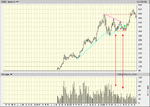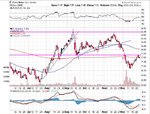The Many Aspects of Support & Resistance...
A wide variety of individual aspects of Support & Resistance are in common use by traders today. Trend Line Support and Trend Line Resistance are but two of them.
I use the following list of individual aspects of Support & Resistance in my work .
When two or more individual aspects of Support or Resistance
coincide (reside within 10 cents of one another) in order to form an area of
concentrated Support or
concentraded Resistance, it is then that I sit up and take notice.
That's because two or more individual aspects of Support or Resistance that
coincide create a much more reliable trading opportunity than does an individual aspect of Support or Resistance that is standing alone.
The following 5-Minute Charts provide a visual representation of how the QQQQ honored its areas of
concentrated Support and
concentrated Resistance over the last few days:
Individual Aspects of Support & Resistance:
From a Daily Chart:
20-Day Moving Average
50-Day Moving Average
200-Day Moving Average
Upper Bollinger Band
Lower Bolling Band
Daily High
Daily Low
Daily Close
Daily Pivot Points (S2, Pivot, R2)
Fibonacci Numbers
From a Weekly Chart:
20-Week Moving Average
50-Week Moving Average
Upper Bollinger Band
Lower Bolling Band
Weekly High
Weekly Low
Weekly Close
Weekly Pivot Points (wS2, wPivot, wR2)
10-Week Trading Band
From a Monthly Chart:
20-Month Moving Average
Upper Bollinger Band
Lower Bolling Band
Monthly High
Monthly Low
Monthly Close
Monthly Pivot Points (mS2, mPivot, mR2)
From a 'Point & Figure' Chart:
Double-Top Breakout (D-Top)
Double-Bottom Breakdown (D-Bot)
Triple-Top Breakout (T-Top)
Triple-Bottom Breakdown (T-Bot)
Bullish Support Line (BSL)
Bearish Resistance Line (BRL)





